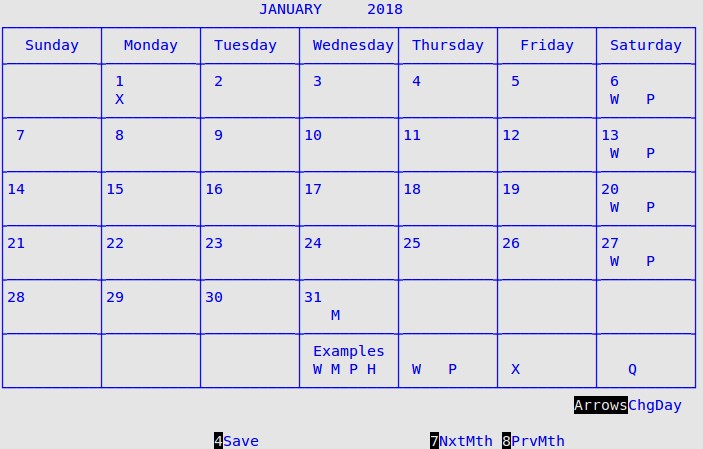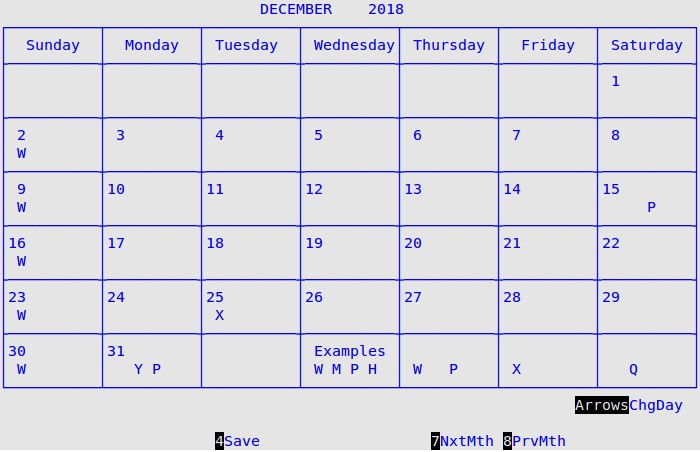The Set Up Calendar function is extremely important. If you do not have a calendar set up for a month, the system cannot complete the weekly, monthly, quarterly, yearly, or payroll closing processes properly.
The calendar controls the way inventory is consolidated, the way both statistics and inventory are reported, and report date ranges. Because we have built as much flexibility into the system as possible, you are able to set the system up so that it reports critical information in the format that best suits your business. Whether you operate on the calendar year, by four 13 week periods, or on a fiscal year that starts in June, the POS system calendar can accommodate you.
The result of this flexibility is greater responsibility on your part. The calendar, and thus your reporting and statistics, only does what you set it up to do. So it is critical that you think through the ways in which you want your closings to run. We suggest you set your system calendar up for the entire year all in one sitting. This gives you a good overall picture of the year and of the type of reporting you can expect to receive from your POS system.
Use the following steps to set up your calendar:
| If you want to indicate. . . | Type this code | In this field |
| Days that you are closed | X | first |
| Weekly closing | W | first |
| Monthly closing | M | second |
| Quarterly closing | Q | second |
| Yearly closing | Y | second |
| End of a pay period | P | third |
| Holiday (used only in overtime calculations) | H | fourth |
| Note: | The Q, M, and Y codes work together. For example, if you are doing a quarterly (Q) closing, the system will do a monthly (M) closing as well. If you indicate a yearly closing (Y), the system will do both a monthly (M) and quarterly (Q) closing at the same time. |
| Note: | You cannot move to another calendar month or save the current calendar month until you have entered a P and an M, Q, or Y for the month. To skip the monthly closing requirement for a calendar month, see the article Setting Up Your System to Skip a Monthly Closing. |
| Note: | If you started using LubeSoft during the middle of a calendar year, you need to indicate which months you did not use LubeSoft to avoid skewing your yearly statistics. In the first field of the first day of any months you did not use LubeSoft, type an S and save the month. This should already be done for you in your setup, but it is a good idea to double-check.
You should also specify when the payroll occurred to make sure your reports based on payroll period closings are accurate. If you started using LubeSoft mid-month, put an X in each day prior to the day you started using LubeSoft. |
For months that are not the end of a quarter or year, there should be an M in the second field of the last day of the month for which the store is open. In the example below, this is January 31st. This store is open 7 days a week. The only day the store is closed is January 1st, New Year’s Day (X). The store has chosen to end the week and the payperiod on Saturdays (W P).

Every three months, use a Q instead of an M to mark the end of a quarter. (If your fiscal calendar follows the calendar year, this would be March, June, September, and December.) In the example below, the store is closed on Sundays, so the quarterly close (Q) happens on March 30th. The quarterly close also performs a monthly close.
This store is closed on Sundays (X), ends the week on Saturdays (W), and has week-long payperiods that end on Saturdays (P).

At the end of your fiscal year, replace the monthly or quarterly close with a yearly close (Y). In this example, that is on December 31st. The yearly close also performs a monthly and quarterly close.
This store is open 7 days a week, but is closed for Christmas Day on December 25th (X). The store ends its weeks on Sundays (W) and has two payperiods a month, on the 15th and the last day of the month (P).
